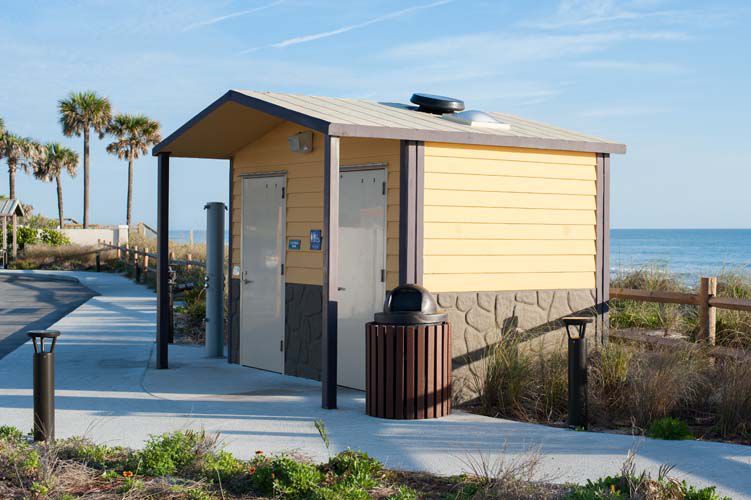
Before the Satellite Beach Community Redevelopment Agency got a hold of it, Shell Street was a sliver of asphalt behind a strip center, adjacent to the shore. Beachgoers relied on a restaurant in the center for bathrooms.
The CRA paid $625,000 to build a restroom, add a pavilion, a shower, more parking and landscaping. Supporters say it is money well spent. But to critics, community redevelopment agencies like the one in Satellite Beach represent good intentions gone awry at the expense of Brevard County.
The pros and cons of CRAs will be debated in a county commissioner workshop on April 13 with their future in the balance.
The state law that created CRAs in 1969 said the focus should be on blight. In critics’ minds, a restroom and shower for those going to the beach don’t qualify.
“CRAs are designated for the purpose of ending or preventing blight, though in reality, they consistently fail to do so,” said Commissioner John Tobia, a strong critic, who would like to see CRAs abolished from Brevard County.
But Courtney Barker, executive director of the Satellite Beach CRA, says Shell Street posed enough problems that the city had no qualms using the agency to fix them in partnership with the owner of the strip center.
Funding for CRAs comes from the annual increase in property tax revenue within the district compared to the initial year of formation. If property values rise as a result of CRA projects the agency gets the benefit. If you add up the 15 CRAs in the county, the money collected since 2002 comes to more than $64 million. Last year, these CRAs received $7.9 million.
If the CRAs did not exist, 40 percent of that $7.9 million would have gone into the county general fund – assuming property taxes increased apace. But property taxes might not have gone up, or gone up as much, without CRA projects, in which case the county would not have received the additional revenue.
The county missing out on money is a thorn in the side of opponents. “The real benefit of all municipal CRAs is they have the county paying 40 percent of the freight and the expenditures are beyond oversight,” said Scott Ellis, Brevard County Clerk of Courts, another critic.
When Satellite Beach created its CRA, organizers believed the district met blighted criteria. “There were no storm water plans, lots were too small to redevelop. They were non-conforming,” Barker said.
A lack of blight seems to explain why other beachside towns like Indialantic, Indian Harbour Beach and Melbourne Beach have no CRAs. “We’ve never considered one,” Melbourne Beach Mayor Jim Simmons said.
Indialantic brought up the possibility some eight years ago.
“There were some who wanted to use the CRA to upgrade Fifth Avenue, to make it more of a tourist destination. A lot of people forcefully opposed the creation of a CRA,” Mayor Dave Berkman said.
Critics say beachside residents pay a price as county coffers are depleted by payments to CRAs. “When I campaigned, I made a promise to taxpayers. Many of our roads are in disrepair. Stopping additional county tax dollars from going towards new CRAs is the first step [to fixing that problem],” said Tobia, whose district includes Melbourne Beach.
The Brevard Coalition, an advocacy group, says tracking CRA expenditures has proven elusive. CRAs are “allowed to do many more things at taxpayer expense without oversight, including bonding out future tax revenue,” coalition member Dave Pasley of Melbourne Beach said.
County spokesman Don Walker said CRAs submit audited annual reports to the county.
The coalition looked into administrative costs for CRAs. “We found out that it was intertwined with the city reports, thus came our request for a CRA template to break out all the costs,” Dave’s wife, Pat Pasley, said. “We’ve never seen the template even though it was voted on by the commission 5-0.”
For all the complaints about shortchanging the county treasury, the commission is the final arbiter in the creation of CRAs.
“The county has the right to say no to CRAs,” said Barker, who doesn’t mind prohibiting additional CRAs as long as the existing ones continue their work. “Cities have invested in project planning, development, and construction. We have debt service based on the county approval. We bought land based on their approval.”
Barker admits CRAs seem better suited for places like Melbourne, Titusville and Cocoa than beachside – places that lost their downtown core as the population moved out into the suburbs, making blight a significant issue.
She cited Cocoa Village as a good example of how a CRA can reinvent an area. “It was a place you did not go. A slum. They created a CRA which led to the development of waterfront condos which funded restoration of the historic district.”
The Bayfront Community Redevelopment District in Palm Bay dates back to 1999. The district encompasses more than 1,000 acres along U.S. 1. Its mission is to develop, redevelop and revitalize the area over a 30-year period, which would take it out to 2029. The plan has identified projects through 2024.
This year’s project involves the Pelican Harbor Marina and surrounding properties.



